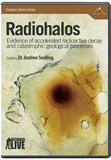Clock in the Rock
Rockin’ around the clock’s assumptions
News Source
- Spacedaily: “NPL and SUERC Calibrate a ‘Rock Clock’”
An unexpected discovery about isotope distribution in atmospheric argon, according to a recent news release, “will improve the accuracy of estimates of the time of geological events.” This refinement will improve “calibration of one of the world’s slowest clocks . . . the ‘argon-argon clock.’”
While designing a thermometer that works by measuring the speed of molecules in argon gas, researchers discovered the accepted isotopic ratio of atmospheric argon is just a little off. The conventional standard established in the 1950s was “slightly in error,” and the correct measurement was finally made in 2006.
“This work shows the power of precision measurement,” said researcher Michael de Podesta. “It's . . . like getting a sharper lens on a camera. It allows us to see the world more clearly.”
Recalibration of the world’s mass spectrometers with the new figure could alter radiometric age measurements by as much as 1.2 per cent. “One per cent change in the accuracy of an age doesn't sound like a lot, but when aiming for 0.1 per cent precision through geological time it is a very significant breakthrough,” said researcher Darren Mark.
Argon-argon dating is supposedly more accurate than potassium-argon dating. Both require accurate knowledge of the atmospheric ratio of argon isotopes. Potassium-argon dating is based on the assumption that the amount of radioactive argon in a rock sample all came from the decay of radioactive potassium. The argon-argon method is calibrated by neutron bombardment of test samples and samples of “known age” as determined by other radioisotopes used for rock dating.
Since argon is an inert gas, many believe any argon previously present in molten rock would have leaked away without reacting with other chemicals before the rock solidified. Those who accept the long age-dates produced by the method are confident of their accuracy because they are sure no argon could have been already present in the sample. However, Dr. Andrew Snelling and others have documented examples in which rocks of truly known ages—known because they were formed in the wake of observed volcanic events—contained excess argon.1 Those who accept the long ages obtained by this radiometric dating method “adjust” for such “excess argon” if the dates don’t match those expected from “known age” rocks. However, “excess argon” is indistinguishable from newly formed argon, and the “known age” rocks for comparison are dated using other radiometric methods founded on the same unverifiable assumptions. The reasoning is circular.2
Improved measurements in the present cannot make assumptions about the past any more reliable.
The new calibration of the atmospheric argon content in argon measurements can only affect one of the steps in the calculation of rock ages. But improved measurements in the present cannot make assumptions about the past any more reliable. Dates with new-and-improved numbers after the decimal point are more precise, but they are not more accurate. In fact, such precision creates the illusion of accuracy.
Precision involves technical refinement in a measurement, but accuracy refers to how closely measurements reflect truth. Precision requires technological improvements of measurements made in the present. Knowledge of accuracy requires testable repeatable confirmable measurements—not possible for events supposed to be billions of years gone—or an eyewitness account. The only eyewitness account of earth’s beginning is God’s account in Genesis. He created all there is about 6,000 years ago. Verifiable scientific observations, as we discuss on this website regularly, are in agreement with the models provided by the Bible. We can have faith in man’s interpretations of the clock in the rock, or we can be wise enough to believe the Word of the one who was there “before all things” (Colossians 1:14-17), the “Rock of Ages,” Jesus Christ.
Further Reading
For More Information: Get Answers
Remember, if you see a news story that might merit some attention, let us know about it! (Note: if the story originates from the Associated Press, FOX News, MSNBC, the New York Times, or another major national media outlet, we will most likely have already heard about it.) And thanks to all of our readers who have submitted great news tips to us. If you didn’t catch all the latest News to Know, why not take a look to see what you’ve missed?
(Please note that links will take you directly to the source. Answers in Genesis is not responsible for content on the websites to which we refer. For more information, please see our Privacy Policy.)
Footnotes
- Snelling, A. A. 1998. Andesite flows at Mt Ngauruhoe, New Zealand, and the implications for potassium-argon ‘dating’, in: Walsh, R. E., Proceedings of the Fourth International Conference on Creationism, p. 503–525. Pittsburgh, Pennsylvania: Creation Science Fellowship.
- See “Radiometric Dating: Back to Basics,” “Radiometric Dating: Problems with the Assumptions,” “Radiometric Dating: Making Sense of the Patterns,” “The Fallacies of Radioactive Dating of Rocks,” and “The Cause of Anomalous Potassium-Argon ‘Ages’ for Recent Andesite Flows at Mt. Ngauruhoe, New Zealand, and the Implications for Potassium-Argon ‘Dating’.”
Recommended Resources

Answers in Genesis is an apologetics ministry, dedicated to helping Christians defend their faith and proclaim the good news of Jesus Christ.
- Customer Service 800.778.3390
- © 2024 Answers in Genesis








